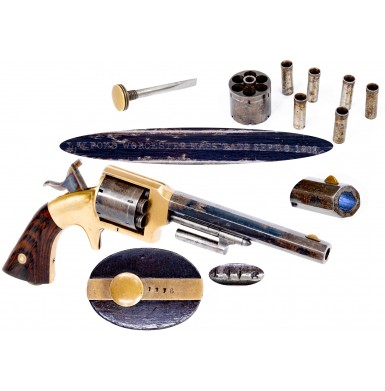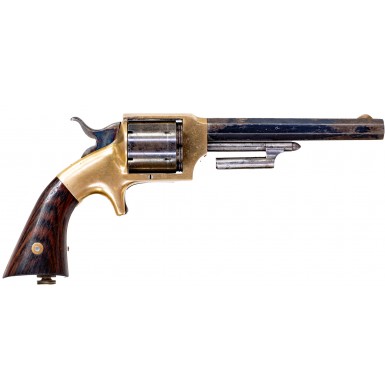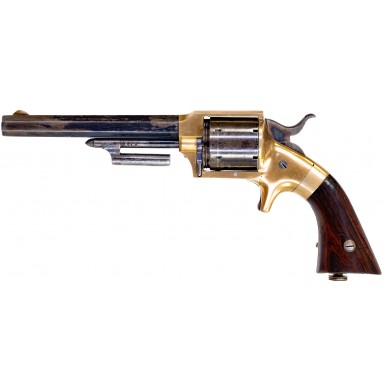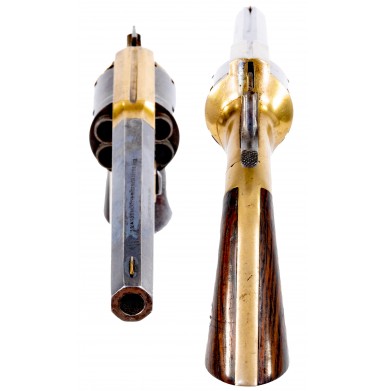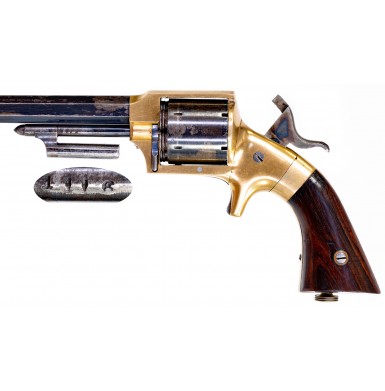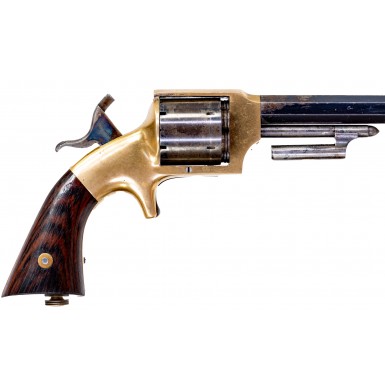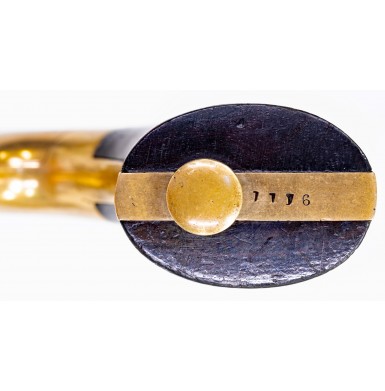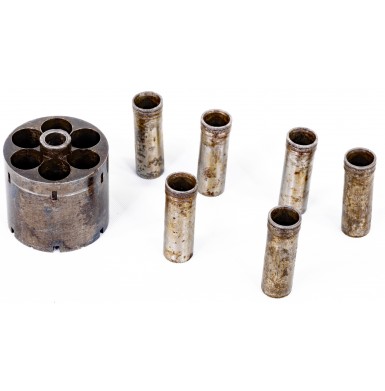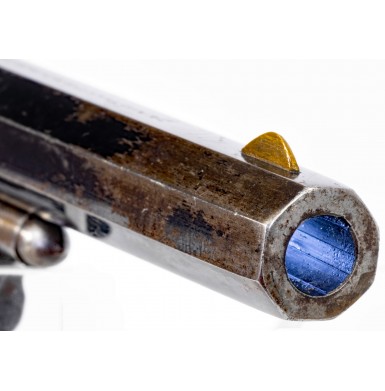Very Fine Lucius Pond "Front Loading Separate Chambers" Revolver
- Product Code: FHG-3546-SOLD
- Availability: Out Of Stock
-
$3,250.00
Lucius W Pond was born in 1826 about 20 miles from Worcester, MA in the town of Hubbarstone, MA. Pond was a gifted machinist and was working in that field at Samuel Flagg’s machine tool business in Worcester by the age of 20. Some eight years later, in 1854, Pond bought out Flagg’s interest in the business and Flagg retired from the trade, although the 70-year-old Flagg would start another machine tool business before the end of the decade. By 1857 the company that had been Samuel Flagg & Co was now operating under the name Lucius W. Pond. The firm made a wide array of small and large tools, including calipers and railroad ticket punchers at the smaller end of the spectrum and “Planing Machines for Iron” and “Engine Lathes” at the larger end. It is not clear what sparked Pond’s interest in the manufacturing of firearms, but as Worcester was a hotbed of gun inventors and manufacturers during the 1850s, he may well have been influenced by the success of local firms like Allen & Wheelock, Smith & Wesson, E.A. Prescott and others.
While it is unclear exactly when Pond turned his machinist’s talents to gunmaking on 17 June 1862 he received US Patent #35623 for “a new and useful Improvement in Revolving Fire-Arms”. The patent covered a tip up barrel self-contained cartridge revolver that was hinged at the rear of the frame, above the recoil shield. This was different that the Smith & Wesson Model 1 and Model 2 designs which were hinged forward of the cylinder. That same day John H Vickers received US Patent #35657 and assigned it to Pond. This was a tip down barrel cartridge revolver design but incorporated the important feature of securing the cylinder to the barrel web assembly, so that opening the action did not set the cylinder free. This allowed the barrel to be tipped down, exposing the rear of the cylinder for loading. Vickers’ design was actually an improvement on the design of another Worcester inventor, John Gibson. He had received US Patent #29126 in 1860 for the original fixed cylinder concept. This particular improvement in firearms design which attached the cylinder to the barrel and web section of the revolver would become essential to the success of Smith & Wesson’s post-Civil War large frame cartridge revolver designs. However, in the summer of 1862, Lucius Pond combined the Gibson and Vickers’ concepts with his tip up design to create a stronger, easier to manipulate cartridge revolver than the guns being produced by Smith & Wesson.
The gun was a single action, spur trigger revolver with a six chambered cylinder chambered for .32RF. The guns were produced with both brass and iron frames and had octagonal barrels that were available in 4”, 5” and 6” lengths. However, Pond apparently did not know, or more likely did not care, that his design utilized a bore-through cylinder, the patent to which was held by Rollin White and assigned to Smith & Wesson. With the Civil War raging and firearms selling as quickly as they could be made, Pond probably assumed that by the time that Smith & Wesson realized his design was an infringement, he would have made a tidy sum. In fact, Smith & Wesson brought suit quite quickly and by March of 1863 Pond had not only lost the suit, but his inventory of tip up revolvers was being confiscated by Smith & Wesson as part of the settlement. Flayderman’s Guide to Antique American Firearms estimates the production of the LW Pond Tip Up Belt Revolvers at “several thousand” and some 4,486 of the guns were surrendered to Smith & Wesson in March of 1863 when the suit was lost. Smith & Wesson paid Pond $7.80 per revolver and then resold them at $12 to $13 each. The Pond revolvers were then marked on the side of the barrel MANUF’D FOR SMITH & WESSON PAT’D APRIL 5, 1855, referencing the Rollin White patent. Flayderman also notes that Pond produced an “Army” sized revolver that was chambered in .44RF based upon the Tip Up Belt Revolver design. However, he notes that only two or three are known and they are unmarked. This suggests that the guns were nothing more than tool room samples and the project was likely scuttled by the loss of the Smith & Wesson lawsuit.
With Pond’s initial foray into the firearms manufacturing business stymied, he proceeded to find a way to circumvent the Rollin White bored-through cylinder patent. To that end Pond received a new patent one day short of a year after his first one, on 16 June 1863. This new US Patent, #38934, covered improvements to his design for a chamber insert which he was no doubt developing to avoid running afoul of the Rolling White patent again. However, the more important patent was granted to Freeman W Hood of Worcester, MA on 8 November 1864 as #44953. This was an improved firearms design based upon the John H. Vickers design of 8 September 1863 which was granted as US Patent #39869 and was assigned by Vickers to himself and Lucius Pond. However, it is Hood’s November 1864 patent that clearly shows what would become known to collectors as the Lucius Pond “Front Loading Separate Chamber” Revolver.
The new Pond design was cosmetically quite similar to his earlier design and was a brass framed single action, spur trigger revolver with a smooth round cylinder and an octagonal barrel. The revolver was produced on a solid frame design and the cylinder was retained by a cylinder pin that entered through the face of the frame and appears to have been based upon Vickers’ 1862 patent. What was unique was the way in which the Rollin White patent was circumvented. While other manufacturers like Plant and Moore had introduced front loading designs to skirt the Rollin White patent, neither were quite as complex nor as convoluted as the Pond-Vickers-Hood design. In fact, only the Slocum sliding chamber revolver produced by the Brooklyn Arms Company approaches the level of complexity and extraneous effort needed to load and unload that the Pond Front Loading Separate Chamber Revolver requires.
The way the gun worked was too clever by half. Each chamber of the cylinder contained a removable sleeve which was inserted through the chamber mouth after the cartridge was loaded into the chamber from its mouth. The sleeve acted as a method of centering the cartridge in the oversized chamber that had been bored large enough to accept the cartridge rim, since the rim could not project from the rear of a bored through chamber. The rear of the chamber was cut with a slot that allowed the firing pin on the face of the hammer to strike the cartridge’s rim to cause ignition. While this system could be used without any convoluted mechanism, it was readily apparent that the removable sleeves were certainly prone to being lost and could be dropped during the loading process. As a result, some sort of mechanism had to be found to help retain the chamber inserts. This was achieved by adding a second projecting rod below and in line with the cylinder arbor pin. At first glance this would appear to be some sort of ejector mechanism to push spent cartridges out of the chambers, but it was actually used to retain the chamber inserts. To load or unload the revolver a spring-loaded switch on the front left of the frame was depressed and the arbor pin and its parallel extension were rotated to the left to align them with the face of the cylinder and a frame recess cut. The revolver was then placed on half-cock and the cylinder could be rotated to align a chamber with the rod. The chamber insert sleeve was then pushed out onto the rod, which retained it and freed the spent cartridge in the chamber to be dumped out. A new cartridge could then be placed in the chamber and the sleeve reinserted in the chamber, securing the cartridge and centering it in the chamber. This somewhat cumbersome process was then repeated for each of the chambers. The loading and unloading process was certainly not fast or simple and at best it was an inelegant way to skirt the Rollin White patent, but it worked.
Over the next few years Pond would produce roughly 7,000 of his convoluted handguns, about 2,000 in .22RF with seven-chambered cylinders and another 5,000 in .32RF with six-chambered cylinders. However, the end of the American Civil War reduced the market for firearms, and in 1869 White’s patent would expire without renewal, making the need to circumvent it with such a complicated design unnecessary. Coupled with the ensuing economic downturn typical of a post-war economy followed by the depression that stated in 1873, Pond soon found himself in financial difficulties. It is hard to believe that a successful machine tool maker who had risen to the status of serving as a director of the Central National Bank, had been a Worcester councilman in 1858 and 1859 and even a Massachusetts State Senator for three years in the post-Civil War era would be reduced to bank fraud to keep himself afloat, but he was. According to research by Michael Helms, published in the American Society of Arms Collectors Bulletin #123, “By 1874, Pond was washing bank checks and re-issuing them to himself for much larger amounts.” One example cited was a $500 check altered to $1,100. With his fraud discovered and seeing few options other than jail, Pond fled Worcester in 1875. Initially he relocated to New York City, then to Hamilton, Ontario. Eventually he decided that abandoning the United States for Australia was his only option. He traveled to San Francisco and booked passage for his escape but was apprehended on the ship by an intrepid detective before it sailed. Pond was then returned to Worcester to face the music. It is estimated that his fraud exceeded $100,000 and after being convicted of his crimes, he was sentenced to 15-years in prison. Eventually he was pardoned by the Governor of Massachusetts in 1882, after only serving six years of his sentence. After his release, he remained in Worchester where he died in 1889.
Offered here is a VERY FINE condition example of one of Lucius Pond’s fairly scarce and rather convoluted Front Loading Separate Chamber Revolvers. The gun is one of the relatively early production guns and is serial number 1116. The matching serial number is found throughout the gun, including on the butt, on the mainspring, on the arbor pin, under the barrel where it is concealed by the arbor pin, on the rear face of the cylinder and in the right grip panel in pencil. The revolver is one of the .32RF guns, built on the same sized frame as his earlier Tip Up Belt Revolvers. The gun has the expected brass frame, a 5” blued octagonal barrel, a color casehardened hammer, square butt that contains a screwdriver and two-piece varnished rosewood grips. The screwdriver was a feature that Pond had introduced in his first revolver design and is a part that is usually missing from these guns when they are found today. The gun has a smooth, round six-chambered cylinder and retains all of the chamber insert sleeves, parts that are also often missing when these guns are found on the market today. The revolver is marked in a single line on the top flat of the barrel:
L.W. POND WORCESTER, MASS. PAT’D SEPT. 8, 1863.
Other than the barrel marking and serial numbers, the gun is unmarked.
As noted, the revolver remains in VERY FINE condition. It retains about 60%+ of the original bright blue on the barrel, which appears to have suffered most of the finish loss due to flaking. The cylinder had flaked as well and retains about 20% of its bright blue. The balance of the barrel and cylinder show a smooth muted bluish-brown patina that tends towards plum in some areas. The brass frame shows no silver plating and was probably lightly cleaned long ago, and now has a lovely, muted butterscotch patina. The hammer retains about 80%+ of its original vivid case coloring, with the majority of the loss along the edges where it has faded and silvered out. The bore of the revolver remains in VERY FINE condition and is mostly bright with strong rifling. The bore shows some frosting and some lightly scattered oxidation. The two-piece varnished rosewood grips remain VERY FINE as well. They retain much of their finish and are extremely crisp. They are free of any breaks, cracks or repairs and show only some lightly scattered minor bumps, dings and mars from handling and use. The revolver remains in excellent mechanical condition and functions exactly as it should. The revolver times, indexes and locks up as it should and remains very crisp mechanically. As noted, the six original chamber insert sleeves are present and they slide in and out of the chambers as they should. The rotating arbor pin works as it should, and the entire mechanism is complete and works as it should.
Overall, this is a really outstanding example of a relatively scarce Lucius W Pond Front Loading Separate Chamber Revolver. The gun retains a large amount of original finish and is extremely crisp and well-marked throughout. It is 100% complete and correct in every way and remains completely functional. Even the small parts that are often lost and missing like the chamber inserts and the screwdriver are present. Guns like this that were intended for carry in an overcoat pocket are rarely found in such wonderful condition with so much finish and this is a particularly attractive example that displays wonderfully. Whether your interests lie in early American cartridge revolvers, Rollin White patent evasion designs or simply the curious and unique designs of early American gun makers, this is a wonderful gun that is not often found on the market in this condition, and which tells a very interesting story. I am sure you will be proud to add this gun to your collection and will enjoy displaying it with other early American cartridge revolvers.
SOLD
Tags: Very, Fine, Lucius, Pond, Front, Loading, Separate, Chambers, Revolver

